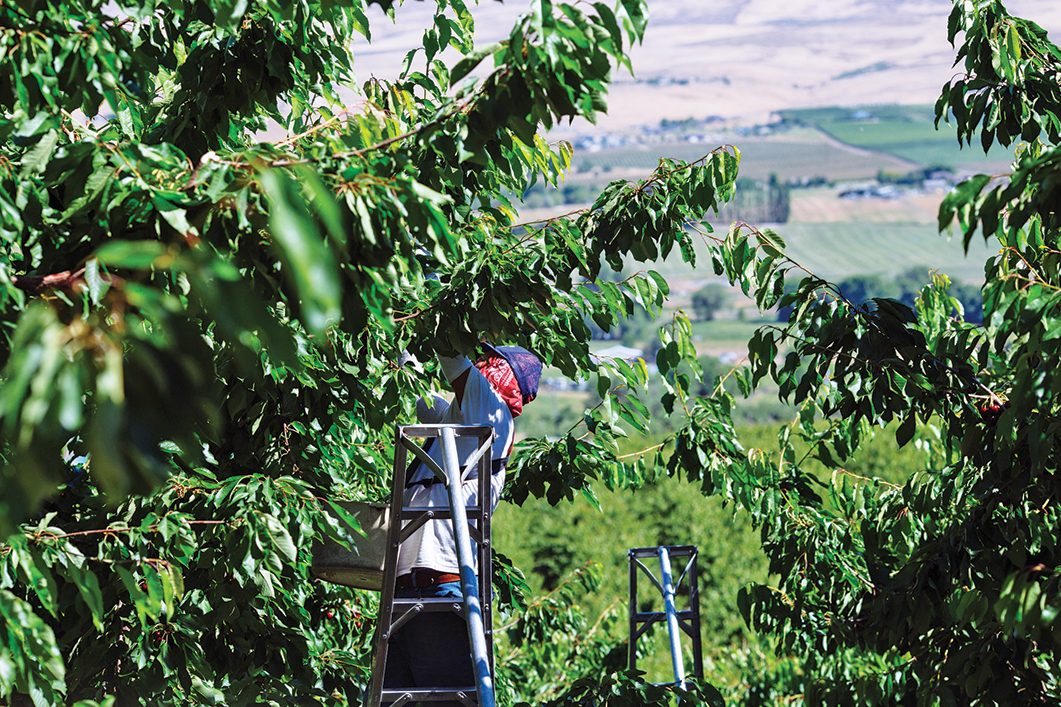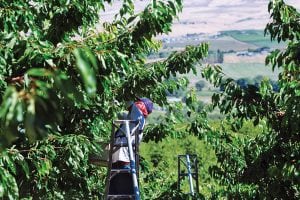
Home » Fierce wage competition: Farms compete for laborers as worker shortage continues
Fierce wage competition: Farms compete for laborers as worker shortage continues

May 6, 2018
By Jennifer L. Drey
An ongoing shortage of agricultural laborers is forcing some Washington farms to get creative in their efforts to attract and retain workers, while others are looking to the federal government’s guest worker program to bring in the help they need.
More than 96 percent of Washington farms experienced a labor disruption in 2016, while 58 percent of farms reported they were affected by labor shortages that year, according to a recent Washington Policy Center farm survey. Farms have reported that the situation only intensified in 2017, said Madi Clark, Washington Policy Center’s agricultural policy research director.
“The number of workers available to work in the ag industry has slowly been decreasing, and depending on who you ask, there’s a lot of reasons why that’s happening,” said Ignacio Marquez, regional assistant to the director at the state Department of Agriculture.
One of the primary drivers of the decrease is that fewer people are crossing the border from Mexico, both legally and illegally, as potential laborers are deterred by a strengthened economy in Mexico and increased border security, Marquez said.
The resulting jobs simply aren’t being picked up by U.S.-born workers, who find them unattractive due to the intensity of the labor and seasonal nature of the jobs.
In the past, migrant workers from other parts of the U.S. have come to Washington to fill the gap. But that too has slowed, as agricultural workers who are already in the country have become more likely to prioritize staying in one community than they were in the past, Marquez said.
“The workers that did this work in the past are getting older or in some cases have moved on to different types of work in different industries,” Marquez said. “As people get more situated, they move to different industries.”
Potential farm laborers often look to the construction industry for year-round work, where pay can be significantly higher. The average annual wage for those working in agriculture in Benton County in 2016 was $27,300. Construction laborers earned an average wage of $57,017 that same year. Franklin County numbers were similar with average wages for agricultural workers at $28,150, versus $47,167 in construction in 2016, according to figures provided by the state Employment Security Department.
With fewer people available to meet the demand for agricultural labor, wage competition has become fierce among farms, making high labor costs one of the most challenging factors currently facing the industry.
“If farmers can’t afford to pay the premium rate for picking cherries or apples, then they really struggle in hiring their work force,” said Ajsa Suljic, regional labor economist for the state Employment Security Department.
Suljic said demand for labor tends to peak in late May or early June with the cherry harvest. While those months tend to bring in migrant workers from other areas, most of them have left the area by the time the apple harvest comes around, she said.
The remaining workers will go where pay is highest and are even likely to leave a job unannounced if they find better pay elsewhere.
With the intensity of the competition to retain workers, farms are evaluating their operations for factors beyond just pay that will make them more attractive to workers, Marquez said.
“I think the ag industry is looking at all options right now and seeing what fits best for them. In some cases, work sites or orchards are in very remote areas, and they have to be very creative to attract people to drive out miles away from the nearest town,” he said.
In the apple and cherry industries, that newfound creativity has taken the form of revamped planting patterns where newer, shorter varieties of trees are replacing older trees. The newer trees are typically planted closer together, which makes harvesting less difficult for the workers.
Some farms are also planting additional crops to create work throughout the year for laborers. An apple or cherry producer may choose to add peaches, blueberries and other seasonal fruits, for example, to ensure year-round work, Marquez said.
Clark at the Washington Policy Center believes that the market will naturally fill in the labor gap with a certain level of mechanization. Marquez agreed that mechanization will help, but said the industry is at least 20 years from being fully mechanized.

“There is some mechanization out there, but it’s not at the point where the industry can look at this as a solution,” he said. “The machines that are out there don’t produce as fast as a human being, and there’s so many other variables — the terrain, the weather, the type of fruit that you’re picking.”
That said, some farms are using mechanization to make work easier where they can, such as offering automated platforms rather than ladders to use during harvest. There are also computerized systems that check the moisture levels of crops in the fields and vacuum systems that take fruit directly to the bin for the worker, he said.
In dealing with labor shortages, Suljic said a growing number of Columbia Basin agricultural employers are also turning to the federal government’s H-2A guest worker program, which allows them to legally hire foreign workers to fill seasonal, time-sensitive agricultural positions when there aren’t enough U.S. workers available.
Statewide, the number of certified H-2A workers was nearly 14 times greater in 2015 than in 2006, according to a recent state Employment Security Department report.
“Americans simply don’t want to do these seasonal, labor-intensive jobs. The guest worker program fills this void,” said Dan Fazio, CEO and executive director of Wafla, a nonprofit agricultural association that provides labor and employment advice for its members, as well as files H-2A applications.
In 2017, Wafla filed more than 200 H-2A applications for 14,000 positions, demonstrating a 29-percent increase from 2016. Wafla filed 60 percent of all H-2A applications filed in Washington.
In mid-February of this year, 117 H-2A applications had already been filed in Washington versus just 78 applications at the same time in 2017.
“H-2A makes sense from an economic perspective,” Clark said.
Under the program, employers and laborers enter into a contract that specifies wages and length of work so that both employer and employee gain stability.
“It’s a reliable source of labor because they lock into a contract with one farm and stay with that farm,” Clark said.
However, the program also can be expensive, as it requires the employer to pay for the workers’ travel expenses, food, housing, child care and other social services. Additionally, some employers find the program to be difficult and time consuming to use.
Large farms often are equipped to bring in workers under the H-2A program without outside help, but the red tape and expense of the program may prove more challenging for smaller farms, which are often hurt the most by labor shortages. Small farms sometimes choose to hire contractors who do the actual work of hiring the H-2A employees, Suljic said.
Making H-2A easier and less costly to use will be necessary in solving the labor shortage in Washington, Fazio said. That’s why his organization keeps an open dialogue with state and federal government agencies involved in the process.
“We are always looking for ways to work with these agencies where willingness on their side is open to make the process run smoother and more efficiently, especially when we see areas that are causing delays,” he said.
Given the programs that are currently in place and the conversations that are happening, Suljic was optimistic about the future of agricultural employment in Washington.
“I just think that this conversation and the talks that are happening are critical for every side in order to have a healthy work force going down the road,” Suljic said.
Agriculture + Viticulture
KEYWORDS focus agriculture viticulture 2018





